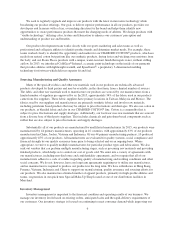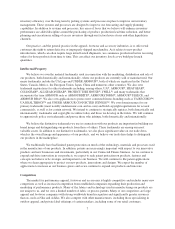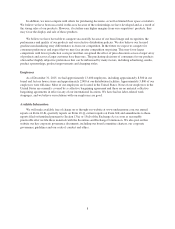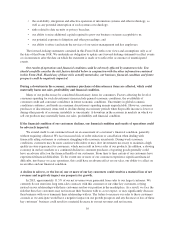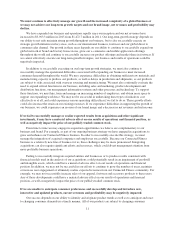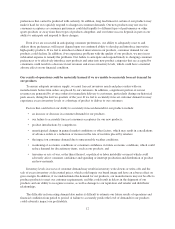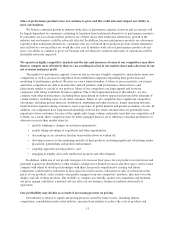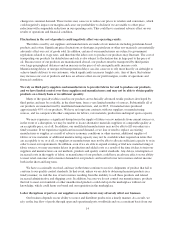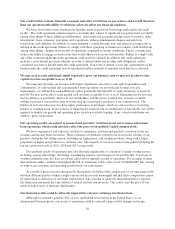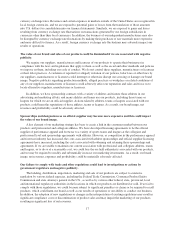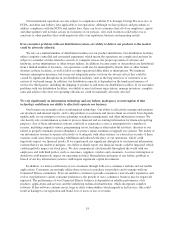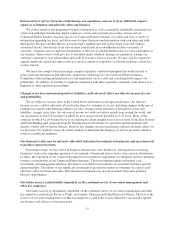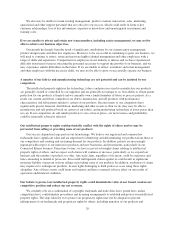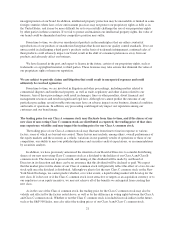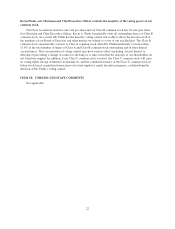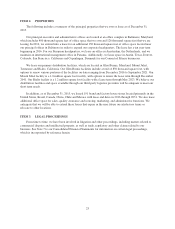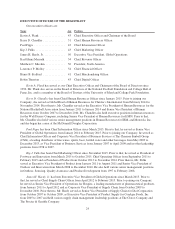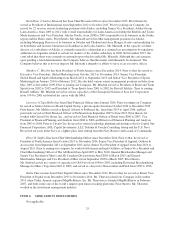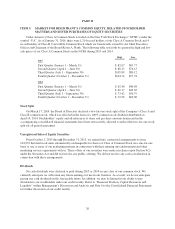Under Armour 2015 Annual Report Download - page 24
Download and view the complete annual report
Please find page 24 of the 2015 Under Armour annual report below. You can navigate through the pages in the report by either clicking on the pages listed below, or by using the keyword search tool below to find specific information within the annual report.Our credit facility contains financial covenants and other restrictions on our actions, and it could therefore
limit our operational flexibility or otherwise adversely affect our financial condition.
We have, from time to time, financed our liquidity needs in part from borrowings made under our credit
facility. The credit agreement contains negative covenants that, subject to significant exceptions limit our ability,
among other things to incur additional indebtedness, make restricted payments, pledge assets as security, make
investments, loans, advances, guarantees and acquisitions, undergo fundamental changes and enter into
transactions with affiliates. In addition, we must maintain a certain leverage ratio and interest coverage ratio as
defined in the credit agreement. Failure to comply with these operating or financial covenants could result from,
among other things, changes in our results of operations or general economic conditions. These covenants may
restrict our ability to engage in transactions that would otherwise be in our best interests. Failure to comply with
any of the covenants under the credit agreement could result in a default. In addition, the credit agreement
includes a cross default provision whereby an event of default under certain other debt obligations will be
considered an event of default under the credit agreement. If an event of default occurs, the commitments of the
lenders under the credit agreement may be terminated and the maturity of amounts owed may be accelerated.
We may need to raise additional capital required to grow our business, and we may not be able to raise
capital on terms acceptable to us or at all.
Growing and operating our business will require significant cash outlays and capital expenditures and
commitments. If cash on hand and cash generated from operations are not sufficient to meet our cash
requirements, we will need to seek additional capital, potentially through debt or equity financing, to fund our
growth. We may not be able to raise needed cash on terms acceptable to us or at all. Financing may be on terms
that are dilutive or potentially dilutive to our stockholders, and the prices at which new investors would be
willing to purchase our securities may be lower than the current price per share of our common stock. The
holders of new securities may also have rights, preferences or privileges which are senior to those of existing
holders of common stock. If new sources of financing are required, but are insufficient or unavailable, we will be
required to modify our growth and operating plans based on available funding, if any, which would harm our
ability to grow our business.
Our operating results are subject to seasonal and quarterly variations in our net revenues and income
from operations, which could adversely affect the price of our publicly traded common stock.
We have experienced, and expect to continue to experience, seasonal and quarterly variations in our net
revenues and income from operations. These variations are primarily related to increased sales volume of our
products during the fall selling season, including our higher price cold weather products, along with a larger
proportion of higher margin direct to consumer sales. The majority of our net revenues were generated during the
last two quarters in each of 2015, 2014 and 2013, respectively.
Our quarterly results of operations may also fluctuate significantly as a result of a variety of other factors,
including, among other things, the timing of marketing expenses and changes in our product mix. Variations in
weather conditions may also have an adverse effect on our quarterly results of operations. For example, warmer
than normal weather conditions throughout the fall or winter may reduce sales of our COLDGEAR®line, leaving
us with excess inventory and operating results below our expectations.
As a result of these seasonal and quarterly fluctuations, we believe that comparisons of our operating results
between different quarters within a single year are not necessarily meaningful and that these comparisons cannot
be relied upon as indicators of our future performance. Any seasonal or quarterly fluctuations that we report in
the future may not match the expectations of market analysts and investors. This could cause the price of our
publicly traded stock to fluctuate significantly.
Our financial results could be adversely impacted by currency exchange rate fluctuations.
Although we currently generate 82% of our consolidated net revenues in the United States, as our
international business grows, our results of operations could be adversely impacted by changes in foreign
16


